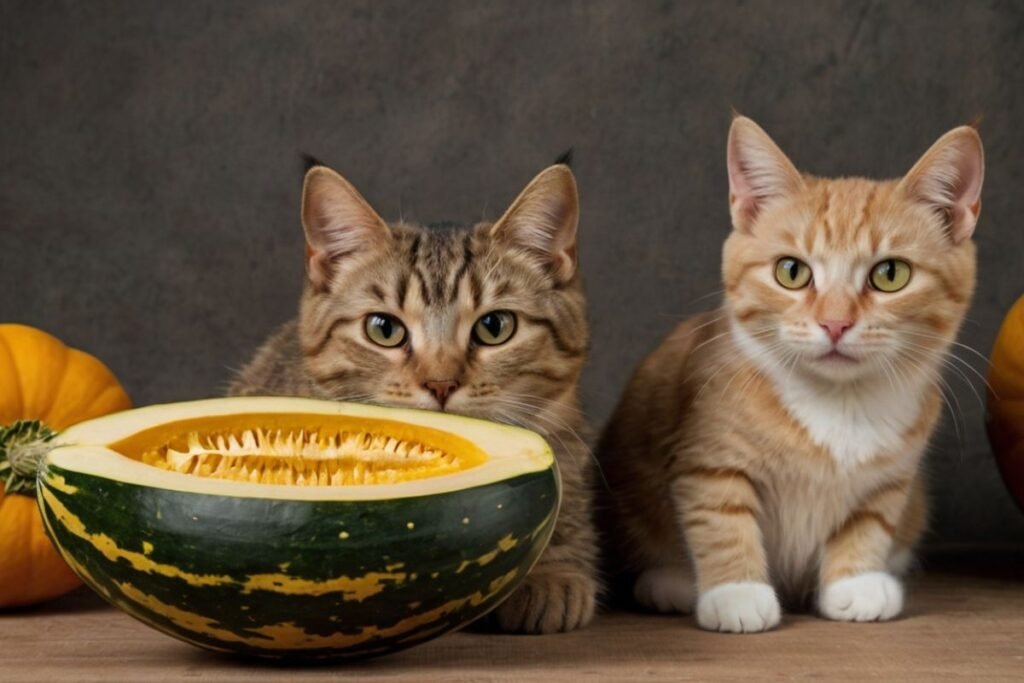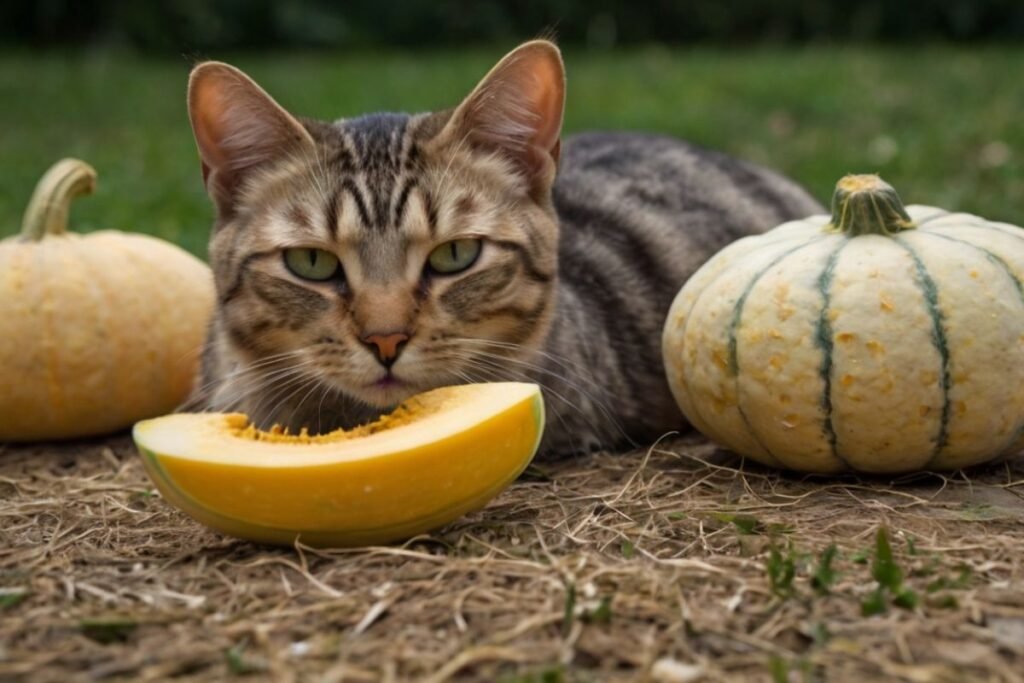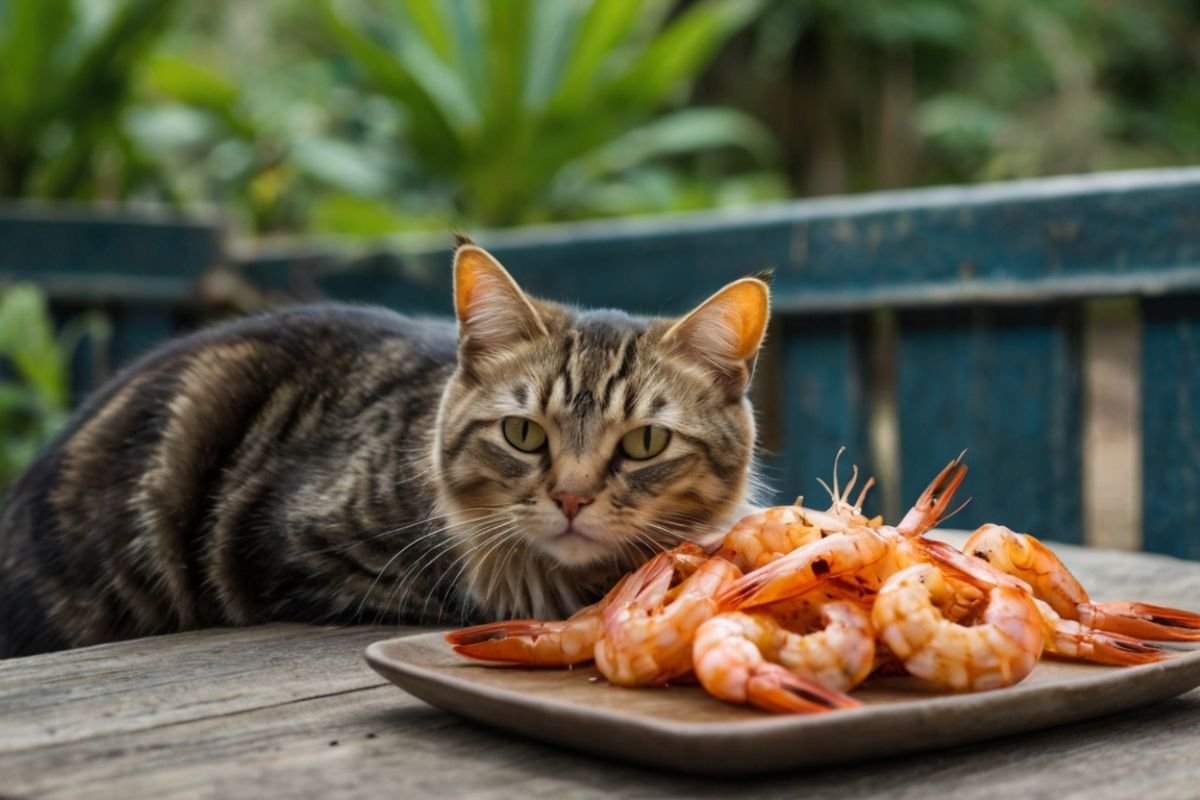You’re cutting up some fresh butternut squash for dinner. Your curious cat wanders into the kitchen. They sniff the air. Then, they look at you with those big, hopeful eyes. Sound familiar?
As cat parents, we face these moments daily. We want to share everything with our furry friends. But we also want to keep them safe. So, can cats eat squash? The short answer is yes – but there’s more to it.
My orange tabby Rio has taught me a lot about cats and food. He’s two years old now. Also, he’s always curious about what I’m eating. Through trial and experience, I’ve learned what works and what doesn’t.
Today, let’s dive deep into everything about cats and squash. We’ll cover safety, benefits, and preparation. Plus, I’ll share real tips from my journey with Rio.
Table of Contents
What Exactly Is Squash?
First, let’s talk basics. Squash belongs to the gourd family. Technically, it’s a fruit. However, most people treat it like a vegetable. There are many types of squash. Each one has its own taste and texture.
Summer squash varieties include:
- Zucchini
- Yellow squash
- Pattypan squash
Winter squash varieties include:
- Butternut squash
- Acorn squash
- Spaghetti squash
- Kabocha squash
- Delicata squash
These varieties are packed with good stuff. They contain vitamins, minerals, and fiber. Humans love them in soups, salads, and baked dishes. But what about our cats?

Is Squash Actually Safe for Cats?
Yes, squash is safe for cats. However, there are important rules to follow. First, it must be cooked properly. Second, it should be served plain. Third, it’s only safe in small amounts.
Cats are obligate carnivores. This means they need meat to survive. Their bodies are designed for animal protein. Squash can be a nice treat, but it can’t replace their main diet.
Think of squash like a healthy snack. It’s not a meal replacement. Instead, it’s something special you can offer occasionally.
Also read, Can Cats Eat Avocado?
The Real Benefits of Squash for Cats
Now, let’s explore why squash might be good for your cat. There are several gentle benefits worth knowing about.
1. Fiber for Better Digestion
Squash contains natural fiber. This fiber helps with digestion. If your cat struggles with constipation, squash might help. The fiber adds bulk to their stool. This makes it easier to pass.
Also, fiber can help with hairballs. It helps move hair through their system. This prevents painful blockages.
2. Low-Calorie Treat Option
Many cats struggle with weight. Squash is naturally low in calories. Therefore, it makes a great treat for chubby cats. Your cat feels satisfied without extra calories.
This is especially helpful during diet time. You can give your cat something special. Meanwhile, you’re not ruining their diet plan.
3. Vitamin and Mineral Boost
Squash is rich in important nutrients. These include:
Vitamin A: This supports healthy vision. It also boosts immune function. Cats need this for overall health.
Vitamin C: While cats make their own vitamin C, extra doesn’t hurt. It supports their immune system.
Potassium: This mineral helps with muscle function. It also supports proper nerve signals.
Beta-carotene: This antioxidant fights free radicals. It helps prevent cell damage.
4. Extra Hydration
Some squash varieties have high water content. This is especially true for summer squashes like zucchini. Extra water is always good for cats.
Many cats don’t drink enough water. This can lead to kidney problems. Therefore, any extra hydration helps their overall health.
How to Prepare Squash Safely for Your Cat
Preparation is everything when it comes to feeding squash to cats. You can’t just grab a raw piece and offer it. Proper preparation keeps your cat safe and happy.
Step 1: Choose the Right Cooking Method
Always cook squash before serving. Raw squash is hard to digest. It can cause stomach upset. Here are the best cooking methods:
Steaming: This preserves nutrients. It also makes the squash soft and easy to eat.
Boiling: This works well too. Just don’t add any seasonings to the water.
Baking: Roasting brings out natural sweetness. However, don’t add oils or spices.
Avoid frying: Never fry squash for your cat. The oils are too heavy for their system.
Step 2: Keep It Completely Plain
This is crucial. Cats can’t handle many seasonings that we love. Never add:
- Salt
- Butter
- Garlic
- Onion powder
- Any spices
- Oil
- Sugar
These ingredients can be harmful or even toxic to cats. Therefore, always serve squash completely plain.
Step 3: Make It Easy to Eat
Cats have small mouths. They also swallow without much chewing. Therefore, you need to prepare squash properly:
Mash it: Soft, mashed squash is perfect. Your cat can easily lick it up.
Cut it small: If you don’t mash it, cut tiny pieces. Think smaller than your fingernail.
Remove all skin: Squash skin is tough. It’s hard for cats to digest. Always peel before serving.
Take out seeds: Seeds can be choking hazards. They’re also hard to digest.
Step 4: Start with Tiny Amounts
When introducing any new food, start small. Give your cat just a tiny taste. Watch for any reactions.
For Rio, I started with just a few licks of mashed butternut squash. He seemed curious but not overly excited. That was a good sign.
Which Types of Squash Work Best for Cats?

Not all squashes are created equal. Some work better for cats than others. Let’s break down the most common types:
Zucchini – The Top Choice
Zucchini is probably the best squash for cats. It’s mild in flavor. Also, it has high water content. Plus, it’s easy to digest when cooked.
Rio actually enjoys zucchini more than other squashes. I steam it until it’s very soft. Then, I mash it with a fork. He licks it right up.
Yellow Squash – Another Great Option
Yellow squash is very similar to zucchini. It has a mild flavor and soft texture when cooked. Most cats who like zucchini also enjoy yellow squash.
Butternut Squash – Sweet but Safe
Butternut squash is a bit sweeter than summer squashes. However, it’s still safe for cats. The sweetness comes from natural sugars, not added sugar.
Just remember to cook it extra well. Butternut squash can be quite hard when raw. Therefore, it needs more cooking time to become soft.
Acorn Squash – Use with Caution
Acorn squash is denser than other varieties. It’s also slightly higher in natural sugars. While it’s not dangerous, it should be given in even smaller amounts.
Spaghetti Squash – Fun Texture
Some cats enjoy the unique texture of spaghetti squash. When cooked, it separates into strands. This can be interesting for curious cats.
However, make sure the strands are short. Long strands could be a choking hazard.
What About Kittens and Squash?
Kittens can eat small amounts of squash too. However, you need to be extra careful. Kittens have more sensitive digestive systems. They also need higher protein diets than adult cats.
If you want to offer squash to a kitten, wait until they’re eating solid food well. Start with just a tiny lick. Watch closely for any stomach upset.
Honestly, kittens don’t really need squash. Their regular kitten food should provide everything they need. Therefore, squash should only be an occasional tiny treat.
How Much Squash Can Cats Eat?
This is one of the most important questions. Too much of anything can cause problems. Even good things become bad in large amounts.
For an average adult cat, here’s what I recommend:
- Start with 1/4 teaspoon
- If they tolerate it well, you can increase to 1 teaspoon
- Never give more than 1 tablespoon at a time
- Offer squash only once or twice per week
Rio gets about 1/2 teaspoon of mashed squash when I offer it. That’s plenty for him. He seems satisfied with that amount.
Remember, treats should never make up more than 10% of your cat’s daily calories. Since squash is low in calories, this usually isn’t a problem. However, it’s still good to keep in mind.
Signs Your Cat Enjoys Squash
Every cat is different. Some love new flavors, while others prefer their usual food. Here are signs that your cat might enjoy squash:
- They approach the bowl eagerly
- They purr while eating
- They lick their lips afterward
- They look for more
- They don’t walk away immediately
On the other hand, some cats will sniff and walk away. That’s perfectly normal too. Never force your cat to eat something they don’t want.
Rio shows mild interest in squash. He doesn’t go crazy for it like he does for chicken. However, he’ll eat it when offered. That tells me it’s an acceptable treat for him.
When You Should Avoid Giving Squash
There are times when squash isn’t a good idea. Here are situations to be careful about:
If Your Cat Has Diabetes
Squash contains natural sugars. While these aren’t as problematic as added sugars, they can still affect blood sugar levels. If your cat has diabetes, talk to your vet first.
If Your Cat Has Kidney Disease
Cats with kidney problems need special diets. Any new food should be approved by their vet. Therefore, don’t add squash without professional guidance.
If Your Cat Has Food Allergies
While squash allergies are rare in cats, they can happen. Watch for signs like:
- Vomiting
- Diarrhea
- Skin irritation
- Excessive scratching
- Lethargy
If you see any of these signs after offering squash, stop immediately. Also, contact your vet.
If It’s Been Seasoned
Never give your cat squash that has been prepared for humans. Restaurant squash often contains garlic, onions, or other harmful seasonings. Even home-cooked squash with butter or salt is off-limits.
What Happens If Your Cat Eats Raw Squash?
Sometimes accidents happen. Maybe your cat snatches a piece of raw squash while you’re cooking. Don’t panic.
Raw squash isn’t toxic to cats. However, it is hard to digest. Your cat might experience:
- Mild stomach upset
- Diarrhea
- Vomiting
- Gas
Most cats will be fine after eating small amounts of raw squash. However, keep an eye on them. If symptoms last more than 24 hours, call your vet.
Large amounts of raw squash could cause more serious digestive upset. Therefore, always keep raw squash away from curious cats.
Can Cats Eat Squash Seeds and Skin?
This is another common question. The answer is more complicated than you might think.
Squash Seeds
Squash seeds aren’t toxic to cats. However, they’re not recommended. Here’s why:
- They can be choking hazards
- They’re hard to digest
- They might cause intestinal blockages
- They don’t provide much nutritional value
Therefore, always remove all seeds before offering squash to your cat.
Squash Skin
Squash skin varies depending on the type. Summer squash skins are usually thinner and softer. Winter squash skins are thick and tough.
In general, it’s best to remove all squash skin before serving. Even thin skins can be hard for cats to digest. They might also cause choking.
Creative Ways to Serve Squash to Your Cat
If your cat enjoys squash, here are some fun ways to serve it:
Mixed with Regular Food
Add a small spoonful of mashed squash to your cat’s wet food. This adds flavor and nutrition without making a big change to their diet.
Frozen Treats
Freeze small amounts of mashed squash in ice cube trays. These make great summer treats. The cold temperature might be especially appealing on hot days.
Squash “Ice Cream”
Mix mashed squash with a tiny bit of low-sodium chicken broth. Freeze it in small portions. This creates a special treat that most cats love.
Training Rewards
Use tiny pieces of soft, cooked squash as training treats. They’re healthy and low in calories. Plus, they’re easy to carry around.
Other Cat-Safe Vegetables to Consider
If your cat enjoys squash, they might like other vegetables too. Here are some safe options:
Steamed Carrots
Cook carrots until they’re very soft. Cut them into tiny pieces. Some cats enjoy the mild sweetness.
Cooked Green Beans
Plain, steamed green beans can be a crunchy treat. Just make sure they’re soft enough to chew easily.
Small Cucumber Pieces
Fresh cucumber can be refreshing. Cut it into very small pieces to prevent choking.
Cooked Peas
A few cooked peas can be fun for cats. They’re small and easy to eat. Plus, they contain protein and fiber.
Steamed Broccoli
Tiny pieces of steamed broccoli are safe. However, many cats don’t enjoy the taste. Therefore, this one is hit or miss.
Remember, all vegetables should be:
- Cooked (except cucumber)
- Plain (no seasonings)
- Cut small
- Offered in tiny amounts
When to Talk to Your Veterinarian
Your vet should always be your first resource for dietary questions. Here are times when you definitely should call:
- Before introducing any new food to a cat with health problems
- If your cat shows any negative reactions to squash
- If you’re unsure about portion sizes
- If your cat has special dietary needs
- If you want to make squash a regular part of their diet
Rio sees his vet regularly for checkups. I always mention any dietary changes during these visits. This helps ensure he stays healthy and happy.
The Bottom Line on Cats and Squash
So, can cats eat squash? Absolutely. When prepared properly, squash can be a healthy, safe treat for most cats. It provides fiber, vitamins, and hydration. Plus, it’s low in calories.
However, remember these key points:
- Always cook squash before serving
- Keep it completely plain
- Start with tiny amounts
- Watch for any negative reactions
- Never use it as a meal replacement
- Consult your vet if you have concerns
Rio enjoys his occasional squash treat. It’s not his favorite food, but he seems to appreciate the variety. Most importantly, it gives me peace of mind knowing I’m offering him something healthy.
Final Thoughts for Cat Parents
Being a cat parent means making countless food decisions. We want to give our cats variety and nutrition. However, we also need to keep them safe.
Squash can be a wonderful addition to your cat’s treat rotation. It’s natural, healthy, and most cats can tolerate it well. Just remember to introduce it slowly and watch for reactions.
Every cat is unique. What works for Rio might not work for your cat. That’s perfectly normal. The key is paying attention to your individual cat’s needs and preferences.
As you explore new foods with your cat, remember to have fun with it. These moments of sharing and discovery strengthen our bond with our feline friends. After all, that’s what being a loving cat parent is all about.
Whether your cat loves squash or completely ignores it, you’re doing great. The fact that you’re researching safe foods shows how much you care. Keep asking questions, keep learning, and keep loving your furry friend. They’re lucky to have such a thoughtful parent.
Frequently Asked Questions
Can cats eat raw squash? No, raw squash is not recommended. It’s hard to digest and might cause stomach upset. Always cook squash before offering it to your cat.
Is squash toxic to cats? No, squash is not toxic to cats. However, it must be prepared properly – cooked, plain, and served in small amounts.
How often can I give my cat squash? Once or twice per week is plenty. Remember, treats should only make up 10% of your cat’s daily calories.
Can squash help with my cat’s constipation? Yes, the fiber in squash may help with mild digestive issues. However, chronic constipation should be evaluated by a vet.
What if my cat doesn’t like squash? That’s completely normal. Not all cats enjoy the same foods. There are plenty of other healthy treat options to try instead.

Shahriar Robin is the creator of WhatPetsCanEat.com, a passionate pet lover and dedicated cat dad to Rio, a curious two-year-old orange feline who inspired this website. With a love for animals and a knack for research, Shahriar shares trusted, easy-to-understand information to help fellow pet owners make safe, healthy food choices for their furry friends.


